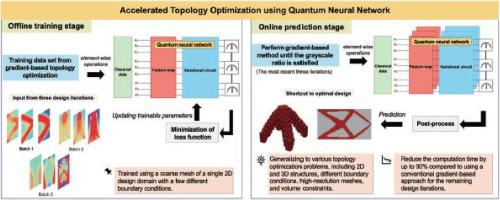Quantum neural network-assisted topology optimization: Concept and implementation with parameterized quantum circuits
IF 7.3
1区 工程技术
Q1 ENGINEERING, MULTIDISCIPLINARY
Computer Methods in Applied Mechanics and Engineering
Pub Date : 2025-09-25
DOI:10.1016/j.cma.2025.118411
引用次数: 0
Abstract
This study proposes a quantum machine learning-assisted approach to accelerating density-based topology optimization using quantum neural network (QNN), a class of trainable models based on parameterized quantum circuits (PQCs). The proposed framework extracts key features from classical data, starting by encoding the corresponding finite element analysis results, i.e., strain energy, sensitivity, and design variables from early design iterations obtained using the standard optimizer. Then, the PQCs are fine-tuned using minimization of the binary cross-entropy loss function, enabling the model to learn the mapping between input features and optimal design. Specifically, the framework consists of two main stages. First, an offline training stage where the QNN is calibrated using precomputed iterative results from a relatively coarse mesh obtained through the standard optimizer, establishing pattern recognition between input features and the final design variables. The second is an online stage where the trained QNN model is integrated with the standard optimizer to accelerate the final design. Numerical results show that QNN requires only a small number of qubits, and once trained on coarse meshes with several different boundary conditions, can effectively integrate with standard optimizers to predict target designs across various configurations, including different resolutions, volume constraints, and loading conditions. Furthermore, the proposed QNN-assisted framework significantly reduces computational time compared to standard iterative approaches, laying the groundwork for solving large-scale problems with near-term quantum computers.

量子神经网络辅助拓扑优化:参数化量子电路的概念与实现
本研究提出了一种量子机器学习辅助方法,利用量子神经网络(QNN)加速基于密度的拓扑优化,量子神经网络是一类基于参数化量子电路(pqc)的可训练模型。该框架从经典数据中提取关键特征,首先对使用标准优化器从早期设计迭代中获得的相应有限元分析结果进行编码,即应变能、灵敏度和设计变量。然后,利用二元交叉熵损失函数的最小化对pqc进行微调,使模型能够学习输入特征与最优设计之间的映射。具体来说,该框架由两个主要阶段组成。首先,在离线训练阶段,QNN使用预先计算的迭代结果进行校准,这些结果来自通过标准优化器获得的相对粗糙的网格,在输入特征和最终设计变量之间建立模式识别。第二阶段是在线阶段,将训练好的QNN模型与标准优化器集成以加速最终设计。数值结果表明,QNN只需要少量的量子比特,并且一旦在具有多种不同边界条件的粗网格上进行训练,就可以有效地与标准优化器集成,以预测各种配置(包括不同分辨率,体积约束和加载条件)下的目标设计。此外,与标准迭代方法相比,所提出的qnn辅助框架显着减少了计算时间,为近期量子计算机解决大规模问题奠定了基础。
本文章由计算机程序翻译,如有差异,请以英文原文为准。
求助全文
约1分钟内获得全文
求助全文
来源期刊
CiteScore
12.70
自引率
15.30%
发文量
719
审稿时长
44 days
期刊介绍:
Computer Methods in Applied Mechanics and Engineering stands as a cornerstone in the realm of computational science and engineering. With a history spanning over five decades, the journal has been a key platform for disseminating papers on advanced mathematical modeling and numerical solutions. Interdisciplinary in nature, these contributions encompass mechanics, mathematics, computer science, and various scientific disciplines. The journal welcomes a broad range of computational methods addressing the simulation, analysis, and design of complex physical problems, making it a vital resource for researchers in the field.

 求助内容:
求助内容: 应助结果提醒方式:
应助结果提醒方式:


